Photo Call RAF Marham, 6 April 2002
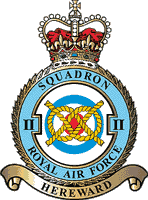
Photo Call RAF Marham, 6 April 2002  |
|
One of the oldest front line flying units anywhere in the world recently celebrated it's 90th anniversary. The subject was No.2 squadron of Britain's Royal Air Force. No. 2 sq, or No. II(AC) squadron as the unit's official title is, is certainly the RAF's oldest fixed wing squadron. No. 1 squadron of course was formed on the same day as No.2 sq, but spent it's first years in existence as a balloon equipped observation squadron. No. 2 squadron has been flying real aeroplanes since inception. No. II(AC) sq was first formed on 13 May 1912. It's first base was Farnborough were the unit flew Bristol Boxkites. Through much of it's life, No. II(AC) sq has had a reconnaisance and Army Support role, hence the AC (Army Cooperation) title. Ever since the end of World War II reconnaissance has been the squadron's role for which Spitfire PR.IX, Spitfire PR.XIX, Meteor PR.9, Meteor FR.10, Swift FR.5, Hunter FR.10, Phantom FGR.2 and Jaguar GR.1 have been used in the past. Today, No. II(AC) sq is based at RAF Marham having been transferred there from Germany in December of 1991 when the Laarbruch Tornado Wing was disbanded. Together with No.13 squadron, like No. II(AC) sq equipped with Tornado GR.4A aircraft, the squadron forms the tactical recce capability of the RAF. As part of the celebrations, the aviation photographer community was very kindly invited to RAF Marham near King's Lynn, Norfolk, UK in order to participate in a Photo Call. Like previous events of it's kind in the UK, aircraft of different types were placed at several locations at the base. RAF Marham's photo call however was exceptionally interesting in that the based Tornadoes could be seen in variety of weapons and stores fits. Add to this some nice foreign visitors and the stage was set for some good shooting. The weather that day was brilliant. Not a cloud to be seen anywhere, apart from those produced by the hamburger stall! Not that those were a problem, though. Many compliments and thanks go to all the staff at RAF Marham who helped to turn 6 April 2002's Photo Call into a very good event. All pictures (c) Hans Rolink. |
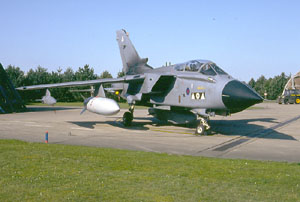
|
Tornado GR.4A ZA404/W is seen here outside it's Hardened Aircraft Shelter (HAS) carrying a pair of 1500 litre wingtanks. These tanks are of the large variety developed for the Tornado F.3 force but have been used since the Gulf War by the GR1/4 fleet as well. Also visible is a BOZ-107 chaff/flare dispenser pod. Hidden in the shadow cast by the jet is the new Goodrich RAPTOR (Reconnaissance Airborne Pod for TORnado). RAPTOR offers better stand-off recce capability than the internal British Aerospace developed TIRRS for which a window can be seen just below and to the left of the roundel on the fuselage. |
| Tornado GR.4A ZA371/C RAF tactical recce jets are never without real teeth. ZA371/C is seen here at Marham visibly carrying a pair of 1000 lbs practice bombs. Although lacking the GR.4's 27 mm Mauser cannons, the GR.4A recce variant can be called upon to drop weapons. Under the aircraft's left outboard wing pylon is a Sky Shadow ECM pod. The aircraft clearly displays the best visible external recognition feature of the GR.4/4A over the GR.1/1A, the new FLIR (Forward Looking Infra Red) pod just below the squadron marking. |
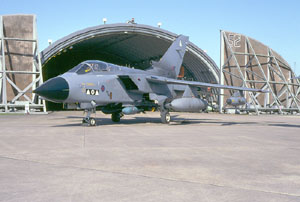
|
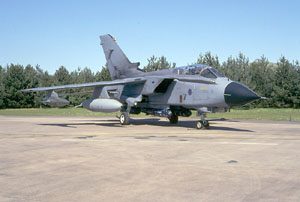
|
Tornado GR.4A ZG711Another example of the RAF's most common unguided air-to ground armament is the Hunting Engineering Improved BL755 Cluster bomb. ZG711 clutches a pair of the training variant of this weapon on it's shoulder pylons. Although unmarked, ZG711 may be assumed to have been part of No.II(AC) sq's inventory at the time the picture was taken. |
|
Tornado GR.4A ZA400/T Precision guided munitions (PGM's) are the buzzwords nowadays. Aircraft like the Tornado in RAF service rely on the TIALD (Thermal Emission Airborne Laser Designator) pod for accurate designation of targets for Laser Guided Bombs. ZA400 carries a TIALD pod under it's fuselage. The Tornado GR.4 uses the British 1000 lbs bomb in combination with the Paveway II seeker head as well as the American BLU-109 2000 lbs warhead with the more accurate Paveway III seeker to destroy hardened buildings. The BLU-109 has a better penetrating power than the older weapon. |
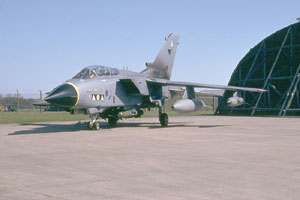
|
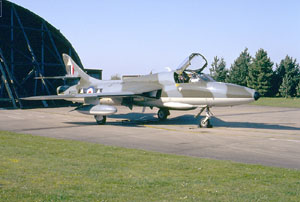
|
Hunter T.7A WV372/R A type of aircraft flown by No. II(AC) sq during the 1960's is the Hawker Hunter. This privately owned T.7A, really G-BXIF, was also on display. Fittingly, it wore II sq livery. The Hunter replaced the Supermarine Swift FR.5 which had proven to be a disaster as a fighter, but a reasonably good aeroplane for reconnaissance. Itself, the Hunter was replaced by the Phantom FGR.2. |
| Tornado GR.4 ZD747/AL Not to be outdone, No.II(AC) sq's neighbours at RAF Marham displayed some of their aircraft as well. No. 9 sq was represented by Tornado GR.4 ZD747/AL, which carried a quartet of ALARM (Air Launched Anti Radiation Missiles). ALARM provides the RAF with a defence suppression capability and is comparable with the American AGM-88 HARM. |
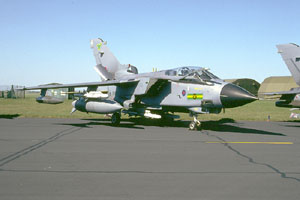 |
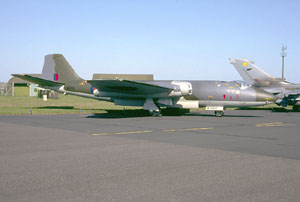
|
Canberra T.4 WJ866 Representing No.39(1 PRU) sq was this Canberra T.4 trainer WJ866. The unit's Canberra PR.9's were either away for operations elsewhere in the world or indoors for maintanance. |
|
Jaguar GR.3 XZ118/FF Another former mount of No.II(AC) sq during it's time in RAF Germany is the SEPECAT Jaguar. Since modified to GR.3 standard, the type still serves with a.o. No.41 sq at nearby RAF Coltishall. Like No.(II)AC sq, 41 sq has a recce task and use large centerline pods to carry the equipment neccessary. XZ118 is seen here without the camera pod. |
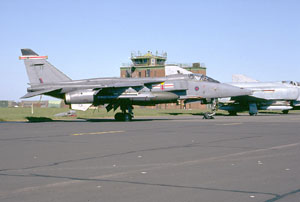
|
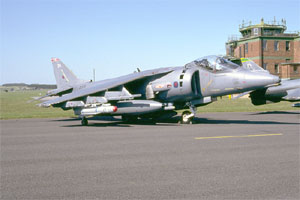
|
Harrier GR.7 ZD376/24 The third major combat type of today's RAF is the Harrier GR.7. Developed from the original Harrier GR.3 and slated to be replaced with the Joint Strike Fighter, this example flies with No.1 squadron out of RAF Cottesmore. Note the AGM-65 Maverick training missile under the wing. |
| Chinook HC.2 ZD984/BJ The RAF's support helicopter force was represented by two types. The well known Chinook HC.2 and a newcomer in the shape of the Merlin HC.3. The former is examplified by ZD984/BJ of No. 18 sq from RAF Odiham. |
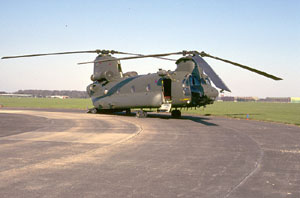 |
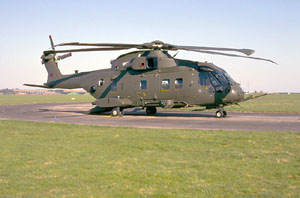 |
Merlin HC.3 ZJ135/T The Merlin HC.3, which is the EH.101 in RAF parlance, in effect is the replacement for the Wessex HC.2. An aircraft from No.28 sq was on show, complete with an in-flight refuelling probe fitted. |
| F-15E 96-0205/LN The USAFE's contribution to the jubilee and the Photo Call came in the shape of an F-15E of the 492nd FS of the 48th FW at RAF Lakenheath. Note the LANTIRN targeting pod on the F-15E's intake pylon. F-15E's of the 366 Wing played a major part in Operation Enduring Freedom and the type has been credited with taking out one of Osama bin Laden's henchmen in a precision attack using the LANTIRN system and LGB's. |
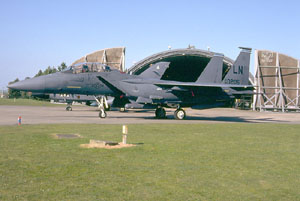 |
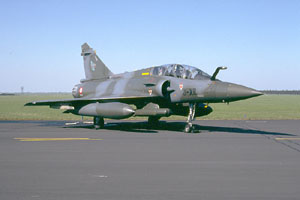 |
Mirage 2000D 659/3-XR Being tasked with a role much similar to that of the RAF's Tornadoes and the USAF's F-15E's, the French Mirage 2000D's also have their LGB guidance kit. The Armee de lÁir use the PDLCT-S (Pod de Designation Laser au Camera Thermique-Synergie) mounted beneath the air intake. This aircraft is from EC 3/3 "Ardennes". |
| F-4F 38+42 Now in the twilight of it's carreer with Germany's Luftwaffe, this F-4F Phantom came from Wittmundhafen's Jagdgeschwader 71 "Richthofen". The type is scheduled to be replaced with the Eurofighter Typhoon. 38+42 is part of a batch of F-4F's updated with modern avionics and systems. The updated aircraft all have grey nose radomes. |
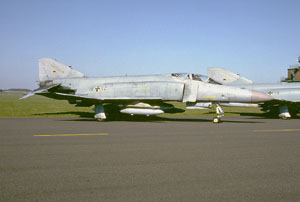 |
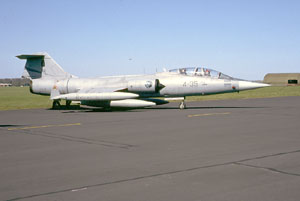 |
TF-104G-M MM54253/4-35 Even older than the German Phantoms are the Italian Starfighters. Italy is even the only user of this type left, but like the German Phantoms the F-104's are to be replaced with Eurofighter Typhoons within the next few years. However, an interim solution in the shape of leased F-16's will be implemented before the Typhoon enters service. |